Biddenham Church Repairs and Alterations
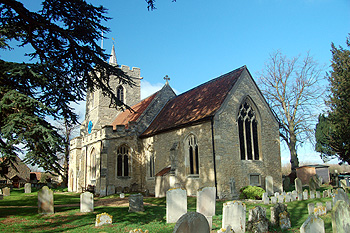
The church from the south-east March 2012
Some of the structural history of the church can be found in detail in Bedfordshire Historical Record Society Volume number 73 of 1994 Bedfordshire Churches in the Nineteenth Century: Part I: Parishes A to G, put together by former County Archivist Chris Pickford from numerous sources some held by Bedfordshire & Luton Archives & Records Service and some held elsewhere or published.
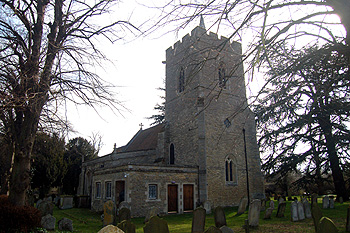
The church from the north-west March 2012
The parish archives held by Bedfordshire and Luton Archives and Records Service [P74] do not give much information about repairs and alterations to the church between the 17th century and the beginning of the 19th century. John Brooks gave a new ring of six bells to the church, together with a clock for the west tower in 1787. The clock was made by William Emerton of Wootton [PB/S4 and PBwP/V16]. In 1836 the church was in good condition, though the archdeacon, following his inspection, called for a few minor repairs. In 1847 the Ten Commandments were placed in the church [P74/5/1].

Carving on the west side of the south chancel east window March 2012
John Martin was the librarian at Woburn Abbey. He wrote a series of descriptions of Bedfordshire churches in the Northampton Mercury under the pseudonym WA. These are usually caustic and highly opinionated. Biddenham was not spared his vitriolic pen. He wrote, in the edition of 23rd October 1847: “The ceiled roof of the chancel of this church has been so judiciously lowered as greatly to destroy the appearance of the window; the railings round the holy table are very common, and the plasterer’s brush has not been spared. The paving of the floor is most wretched. There is a square pew and a stove; remains, doubtful if original, of the screen, which is supplied with a rod and curtain, converting the chancel on occasions into a robing room – a contrivance only worthy of a provincial theatre company. A similar curtain is drawn across the chancel door, for which, seeing this part of the building is disfigured by a stove, there would appear to be no necessity”.
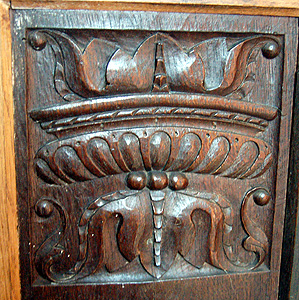
Detail from the south chapel screen March 2012
“The roof of the nave and aisles is ceiled. The pulpit and reading desk very indifferent. Fine old open settings prevail for the most part; one square box faces the pulpit, high enough in its ugliness, but this has not sufficed for the exclusive admirers of worship, and it is supplied with some ragged red curtains In addition. The western window is shut out by a gallery and some boards. The font retains its original leaden lining and drain, but to no purpose, for a basin in used instead. A very large portion of the north aisle is taken up by an enclosure of preposterous size, formed out of some magnificent panelling, never intended originally to be diverted to such a purpose [now separating the south chapel from the nave]. It does not come within our province to say what part of the church it did adorn though we have a pretty good guess upon the matter. When the purer taste exhibited in Saint Cuthbert’s [Bedford] shall be more effectively cultivated, this monstrosity, with the whole abominations of enclosed pews which disfigure almost all the churches in this county, will be happily swept away”.
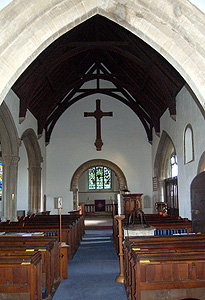
The interior looking east March 2012
The church was restored and reseated by James Horsford at a cost of £842 in 1861 and 1862 [P74/2/2/1 and P74/5/2]. Thirty years later more work was carried out by Bedford architects Usher and Anthony [CDE157/1-2 and P74/2/2/3].
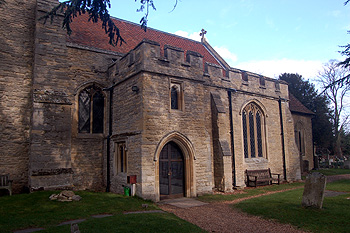
The south porch March 2012
The state of the church in 1879 is revealed in an anonymous article in the Bedfordshire Times (7th June). It reads: “The south porch has a stone seat on the east side, forming a pleasant waiting place for service in summer whatever more official uses it may once have had. The wall of the south chapel is battlemented, and with the chancel – in which is a priest’s door – is partly covered in ivy. Most of the windows are Perpendicular; but the eastern window of the chancel is Decorated. There appears to have been a door in the tower on the south side, but it is now built up, and the tower is entered by a modern flight of stone steps on the north side leading through a doorway – which is also evidently modern – into the clock room, immediately below the bell loft. The six bells, as well as the clock date – in their present form at least – from 1787, when they were placed where they are by one and the same benefactor. One of the bells tells us that “Five old bells were cast into six at the expense of John Brooks”. All the bells bear the name of William Emmerton, of “Wooten”, as the maker. One has the additional legend “Be light and glad, in God rejoice” and another “Blessed is the name of the Lord”. Both the tower and the south side of the church retain in the gargoyles striking evidence of the medieval genius for sculpturing the grotesquely ugly. A south door near the west end of the north aisle still remains in the outer wall; but inside, recent restorations [presumably 1861-1862] have closed it”.

The font March 2012
“On entering the church – which is dedicated to Saint James – by the south porch, the visitor at once sees the tall octagonal font with its carved panels, and shield-bedecked pedestal. The lower part of the tower forms a continuation of the nave, through a pointed arch, and is fitted with a raised gallery for the Sunday School children. Against the north pier of the arch stands the harmonium which leads the singing. The interior of the church shows traces almost everywhere of recent restoration and repair, and the east wall of the chancel remains perfectly bare and plain. The chancel floor is neatly paved with encaustic tiles, and the vertical surface of the step leading to the altar-place bears the legend “I will not leave you comfortless. I will come to you”. The chief features of interest in the altar-place is the old tapestry altar cloth, dated 1549, and having in two corners the word ROLOFUOS. A piscina, with a scalloped basin, forms a niche in the south aisle or chapel. The chancel opens into the nave under a Norman arch, which has a modern look about it. A screen now stands in the north aisle, cutting off a small space at the end for the purposes of a vestry. The fretwork at the heads of the panels, which are now filled in with crimson cloth, is singularly varied, and it is difficult to find any law regulating the variation. This screen is said to have stood in the chancel, but it is much too large for the west end of the chancel, unless that west end has been modified. The wall flanking the Norman arch must, however, be older than the Reformation, as it contains on each side a large “squint”, or oblique opening, through which the elevation of the host was visible to the worshippers west of the arch. The screen may have been placed east of the arch after the Reformation, when the elevation of the host was no longer an important part of the worship. If there is no historical evidence of the original position of the screen, I would suggest it might have divided the south chapel from the nave [as it does today]. That chapel is entered by a single segmental pointed arch spanning a space about equal to the width of the screen. The north aisle has two arches, with corbels borrowed from the armorial bearings of the Botelers of Biddenham and the Dyves of Bromham. The chancel arch has at present a decoration of white letters on a scarlet ground containing “God, even our own God shall give us his blessing”. In the screen-formed vestry is a long oaken chest, iron-bound, which I believe contains some old Black Letter books. The reading desk and pulpit stand on the north and south sides respectively of the chancel arch, and are of oak. The pulpit has some well-executed vine and leaf carving under the upper moulding. The whole of the church is seated with solid oak benches, which are comfortable to sit upon as well as pretty to look at”.

The east window March 2012
In 1897 stained glass by Charles Eamer Kempe was placed in the chancel east window in memory of Charles Howard who had died two years earlier. He had been a local farmer and lived at Biddenham Manor.
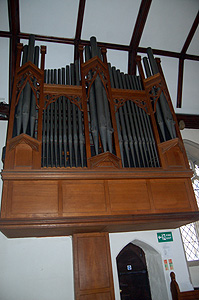
The organ March 2012
In 1899 a new organ by Bishop & Son of London was installed, costing £373/13/6 [P74/2/2/5]. It was moved from the chancel to the west end during the Second World War [P74/2/2/14]. A chamber to house the organ blower was built in 1944 [P74/2/2/16]. The organ was rebuilt in 1966 [P74/2/2/22]. It was moved again, to the north side of the chancel, in 1965 [P74/2/2/26-28].
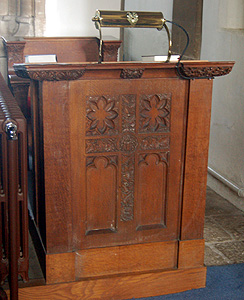
The prayer desk March 2012
Local architect Charles Edward Mallows was responsible for a number of additions in the first years of the twentieth century. These included the lectern in 1902, the prayer desk in 1903, the altar in 1906 and an oak board with an inscription in 1908.
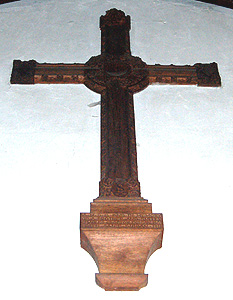
The rood designed by Charles Mallows March 2012
In 1912 Mallows designed the oak cross over the chancel arch. His son, Wilfred Mallows recalled: “I remember my mother saying that my father was very annoyed at this Cross being fixed so high up and flat against the wall: he thought it should have been lower and tilted forward so as to be clear of the wall, so that the very fine carving could be seen properly”. The cross was carved by a Miss Duigan who is buried in the graveyard beneath a Celtic cross also designed by Mallows.

The south chapel looking east March 2012
In 1931 electric light was installed in the church [P74/2/2/9]. An inscription at the west end records that in 1939 the south chapel was restored in memory of William Eglesfield Bathurst Norman, vicar from 1890 to 1935. It was at this date that the screen was moved from the north aisle back to what had probably been its original position [P74/2/2/11].
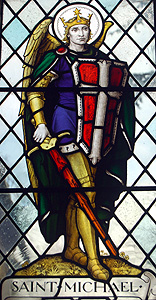
Saint Michael from the south chapel east window March 2012
In 1949 the east window of the south chapel was fitted with stained glass [P74/2/2/20] and a number of repairs were carried out over the next few decades including renovation of the roof and stonework of the tower in 1951 [P74/2/2/21], repair of the chancel between 1955 and 1969, repair of the porch in 1958 and repair to the floor of the vestry in the north aisle in 1966 [P74/2/2/22].
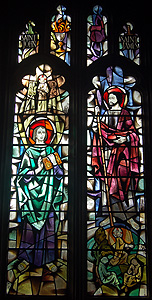
The chancel south window March 2012
In 1969 stained glass was fitted into a window in the south wall of the chancel [P74/2/2/29-31]. The window was donated by Sir John and Lady Howard.
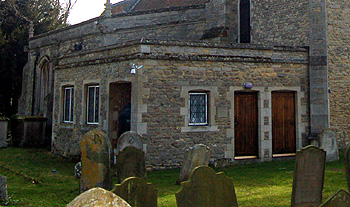
The vestry March 2012
In 1974 a new vestry was added to the north side of the church [P74/2/2/32]. The cost was raised by the sale of the tapestry mentioned by the newspaper article of 1879 to the Victoria and Albert Museum for £1,800 [P74/2/2/33].
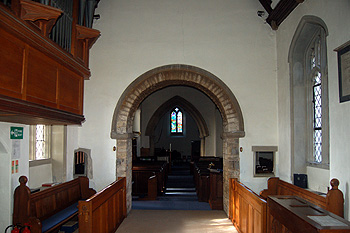
The interior looking west March 2012
In the 1980s repairs were carried out to several parts of the church. These include the floors and pews, rewiring and masonry repairs in 1981 [P74/2/2/34], demolition and removal of the south chapel roof and adjoining nave parapet and repair of the south side of the new roof in 1982 [P74/2/2/36], rewiring between 1983 and 1985 [P74/2/2/39], treatment of pew bases between 1985 and 1987 [P74/2/2/40] and redecoration in 1987 [P74/2/2/42].
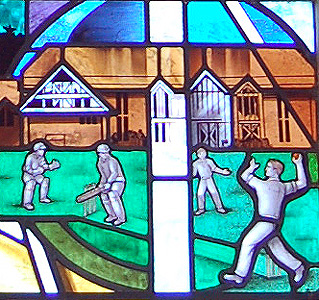
Detail from the west window March 2012
Two new bells were donated in 1987 bringing the peel to eight bells [P74/2/2/41]. The stained glass in the west window in the north aisle was installed in memory of Sir John Howard of engineering form C. A. E. C. Howard “to commemorate the joy and happiness to found in Saint James’, Biddenham”. He was churchwarden from 1957 to 1984 [P74/2/2/43]. In 2000 stained glass was placed in the west window of the tower [P74/2/2/43].
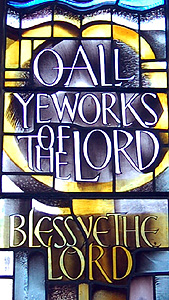
Text from the north aisle west window March 2012